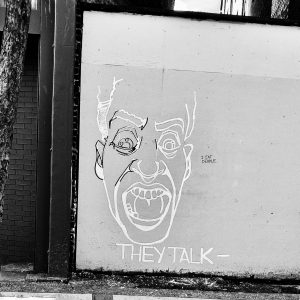Borders Inside Cites

I went to Chinatown recently on a Saturday. I not only went to the supermarket nearby but visited the Chinatown for the first time. I know it is closed on weekends, but I was still stunned. I felt uncomfortable walking on the street. Few people were on the street and most of them were the homeless people who are a little bit mentally unhealthy. It seemed that no one lives in the neighbourhood and buildings are thickly covered with graffiti. I took a photo of a graffito. It is an angry human face shouting “I EAT PEOPLE”, I assume, with the words “THEY TALK” below referring resistances from marginalized people there.
The border exists not only between two countries but inside a country or even a city. Chinatown can be regarded as a practice of “bording” inside the city. During the late 19th century, responding to the development of the city of Vancouver, a small settlement of Chinese immigrants started to form their own neighbourhood located on the southern fringe of the emerging city center (Ng, 10). Most people chose to live here because it was comfortable, and offered them protection from racist violence (Ng, 11). Even these immigrants stayed in Canada with legal status and had legal jobs, they were still considered as outsiders who were commodified and exploitable as well as cheap labour force and were treated unfairly. They were kept out of the city and had to live with the other Chinese immigrants in their “safe zone” with feelings of belongings. Once they went outside of the neighbourhood, they were discriminated and bullied. Thus, the Chinatown can be considered as a small version of “China” in Vancouver at that time; the border between Chinatown and the city of Vancouver worked as the border between China and Canada.
However, gentrification threatens the Chinatown in the recent year. In the documentary, Everything will be, Chinatown is no long as bustling as it used to be in 80s and the residents are facing high pressure and some of them have to leave. As Henry Yu pointed out in his essay, Vancouver have become the “Switzerland of the Pacific”. Young students from Asia, like me, come to Canada for better education and some of them had become or will become Canadian citizens; a lot of rich Asia merchants migrant to Vancouver for safe heaven for wealth offered (Yu, 1020). These new immigrants are not willing to live in Chinatown or other ethnic neighbourhoods but live in the new and young area like in Richmond BC. Now, the fading Chinatown becomes the place of the marginalized homeless people. I notice that the homeless people in downtown area are relatively mental healthy but the homeless in Chinatown are not. I assume that these homeless people are bullied and discriminated at the other part of the city and try to live inside their own community like the early Chinese immigrants, then they find the fading Chinatown where the city does not pay any attention to. They are isolated and “borded” inside in those blocks.
Chinatown is not unique to Vancouver but in almost every major city in North America, like Toronto, New York City, Washington D.C. etc. Some of them are threatened by gentrification, and Chinese Americans start to leave Chinatown as well. According to The Washington Post, only about 300 Chinese Americans live in Washington D.C.’s Chinatown because the owners planned to demolish the buildings for better development. The tenants are fighting to be able to stay as they feel safe there. As I illustrate above, these Chinese Americans are “borded” inside the Chinatown since they are discriminated and feel uncomfortable in other part of the city. Besides the immigrants, the local people sometimes are “borded” inside the certain area in the city as well. The Indian-American documentary, Born into Brothels, is about the children of the prostitutes in Sonagachi, Kolkata’s red light district. Most of the children stay in the U.S afterward and finish their education but one of the kids went back to Indian due to her family issue and became a prostitute. She was isolated in the Indian school as soon as her classmates found out her story.
Work Cited
Ng, Wing. The Chinese in Vancouver, 1945-80: the pursuit of identity and power. UBC Press, 1999.
Yu, Henry. “Global Migrants and the New Pacific Canada.” International Journal, vol. 64, no.4, Autumn 2009, pp.1011-1026
Wang, Yanan. “D.C.’s Chinatown has only 300 Chinese Americans left, and they’re fighting to stay.” The Washington Post, 2015, https://www.washingtonpost.com/lifestyle/style/dcs-chinatown-has-only-300-chinese-americans-left–and-fighting-to-stay/2015/07/16/86d54e84-2191-11e5-bf41-c23f5d3face1_story.html?utm_term=.6797e7828cc6
Everything Will Be. Directed by Julia Kwan, National Film Board of Canada (NFB), 2014
Born into Brothels: Calcutta’s Red Light Kids. Directed by Zana Brisiki and Ross Kauffman, Red Light Films and HBO/Cinemax Documentary, 2005